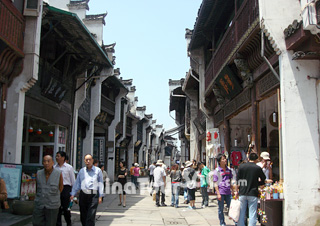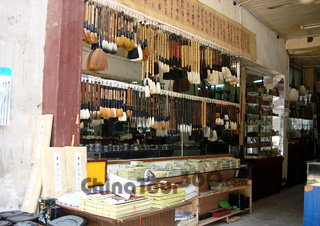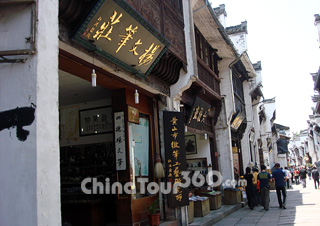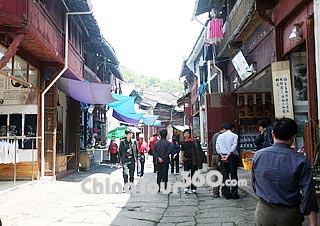 Tunxi Ancient Street, Huangshan
Tunxi Ancient Street, Huangshan Writing Brushes
Writing Brushes Shops in Tunxi Street
Shops in Tunxi Street Tunxi Ancient Street
Tunxi Ancient Street
Tunxi Ancient Street, lies in the center of Tunxi District, is the commercial street characterized by the architectural style of Song (960 - 1279), Ming (1368 - 1644) and Qing (1644 - 1911) Dynasties in complete preservation in China. It is compared to be the moving riverside scene of the Qingming Festival.
The street starts in the west at Zhenhai Bridge, a stone arch bridge built during Ming Dynasty, and ends up in the east with the tablets of the memorial archways. It runs about 1,237 meters (1,353 yards) in total length and five to eight meters (5.5 - 8.7 yards) in width. It is a commercial street only for pedestrians. Merchants from different places assemble here doing their business.
Tunxi Ancient Street has centuries-old history. Tunxi was originally a wharf at the confluence of Xin'an River, Heng River and Lü River. The west end of the street, actually a section of try square shaped street closely connected to the bridgehead of Laoda Bridge, was the cradle of the Ancient Street as well as Tunxi.
The formation of Tunxi Ancient Street can trace back to over 700 years ago, during the Song Dynasty. It was Emperor Huizong (1082 - 1135) that shifted his ruling center to Lin'an (the present Hangzhou). A lot of labor force was conscripted to build the new capital for him. After those workmen went back to their home, they began to model after the architectural style of the new capital, thus the Ancient Street is also named as Song Street. When it was early Ming Dynasty, a businessman called Cheng Xiongzong in Anhui made the investment to have 47 stores built, which helped to attract the settlement of more businessmen. The continual enlargement of the scale in the Qing Dynasty made the Ancient Street the present size.
When you walk into the Ancient Street now, you seem to have stepped into the past. More noteworthy are the buildings from Ming and Qing Dynasties. Unlike the modern architecture, most of the buildings are only three-storeyed high, stone-based and brick-laid. They are decorated with small green tiles, wood carvings, and red-lacquered with double eaves on the roofs looking simple and elegant. It is nearly the same pattern for all buildings that the front functions as the stall for business, and the workshop or the living quarter is in the back of the building. It is easy for you to rest and attain mental tranquility in the Ancient Street.
Shops and stands are open rows upon rows. Some are time-honored brands with a history of more than 100 years, such as Tongderen Medicine Shop, Tonghe Steelyard Store, Chengdexin Sauce and Pickle Shop. There is also the antique street and the street exclusively for sale of the treasures of study. The bonsai, ink stones, brushes, local teas, Mao badges are everywhere to be found in this street. Not only the buildings are in the archaic style, their production, display together with the operational layout remains the old way.
As the Ancient Street preserves the charm of the old town, it was once reputed as the Oriental Ancient Rome by a foreign visitor. The agreeable environment and quaint beauty make it the favorable settings for movies and plays. More and more international travelers have been beckoned here by its unique charms.
![]() Entrance Fee: Free
Entrance Fee: Free
(CNY 20 for Wancuilou Museum)
![]() Transportation:
Transportation:
A. Take Bus No. 6 from the railway station and get off at Sanma Road; or take Bus No. 12 from the railway station and get off at Yuzhong Garden stop;
B. Take Bus No. 1, 2, 5 or 7 in the city.







